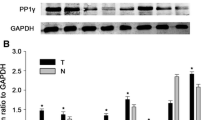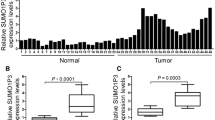Abstract
Purpose
To investigate the expression of SUMO-1 in human hepatocellular carcinoma (HCC) cell lines and clinical HCC samples.
Methods
RT–PCR and Western blot were used to detect the expressions of SUMO-1 in HCC cell lines, clinical HCC samples,and the non-neoplastic liver tissues adjacent to HCC. After transfection of SUMO-1 siRNA into HCC cell line SMMC-7721, the expression levels of Bcl-2, c-Myc and α-tubulin were examined, and MTT assay and cell cycle analysis were carried out as well.
Results
Overexpressions of SUMO-1 were detected in HCC cell lines and clinical HCC samples, while the expression level of SUMO-1 in the non-neoplastic liver tissues was significantly lower (P < 0.001). Transfection of SUMO-1 siRNA resulted in 73.43% of maximal silencing efficiency of SUMO-1 in 48 h. The expressions of Bcl-2 and c-Myc were down-regulated coincidentally. SUMO-1 siRNA notably inhibited SMMC-7721 cells proliferation in vitro and increased the ratios of G2 phase and S phase in the cells.
Conclusions
Owing to overexpression of SUMO-1 in HCC and its important role in the development of HCC, SUMO-1 could be a latent target in diagnosis and therapy of HCC.






Similar content being viewed by others
References
Amati B, Brooks MW, Levy N et al (1993) Oncogenic activity of the c-Myc protein requires dimerization with Max. Cell 72(2):233–245
Bantounas I, Phylactou LA, Uney JB (2004) RNA interference and the use of small interfering RNA to study gene function in mammalian systems. J Mol Endocrinol 33(3):545–557
Brunelle JK, Santore MT, Budinger GR et al (2004) c-Myc sensitization to oxygen deprivation-induced cell death is dependent on Bax/Bak, but is independent of p53 and hypoxia-inducible factor-1. J Biol Chem 279(6):4305–4312
Buschmann T, Fuchs SY, Lee CG et al (2000) SUMO-1 modification of Mdm2 prevents its self-ubiquitination and increases Mdm2 ability to ubiquitinate p53. Cell 101(7):753–762
Cao X, Bennett RL, May WS (2008) c-Myc and caspase-2 are involved in activating Bax during cytotoxic drug-induced apoptosis. J Biol Chem 283(21):14490–14496
Carter S, Bischof O, Dejean A et al (2007) C-terminal modifications regulate MDM2 dissociation and nuclear export of p53. Nat Cell Biol 9(4):428–435
Deyrieux AF, Rosas-Acosta G, Ozbun MA et al (2007) Sumoylation dynamics during keratinocyte differentiation. J Cell Sci 120(Pt 1):125–136
Di Bacco A, Ouyang J, Lee HY et al (2006) The SUMO-specific protease SENP5 is required for cell division. Mol Cell Biol 26(12):4489–4498
Duan H, Heckman CA, Boxer LM (2005) Histone deacetylase inhibitors down-regulate bcl-2 expression and induce apoptosis in t (14; 18) lymphomas. Mol Cell Biol 25(5):1608–1619
Itahana Y, Yeh ET, Zhang Y (2006) Nucleocytoplasmic shuttling modulates activity and ubiquitination-dependent turnover of SUMO-specific protease 2. Mol Cell Biol 26(12):4675–4689
Iyer NG, Chin SF, Ozdag H et al (2004) p300 regulates p53-dependent apoptosis after DNA damage in colorectal cancer cells by modulation of PUMA/p21 levels. Proc Natl Acad Sci USA 101(19):7386–7391
Jones MC, Fusi L, Higham JH et al (2006) Regulation of the SUMO pathway sensitizes differentiating human endometrial stromal cells to progesterone. Proc Natl Acad Sci USA 103(44):16272–16277
Kang JS, Saunier EF, Akhurst RJ et al (2008) The type I TGF-beta receptor is covalently modified and regulated by sumoylation. Nat Cell Biol 10(6):654–664
Karamouzis MV, Konstantinopoulos PA, Badra FA et al (2008) SUMO and estrogen receptors in breast cancer. Breast Cancer Res Treat 107(2):195–210
Kim KI, Baek SH (2009) Small ubiquitin-like modifiers in cellular malignancy and metastasis. Int Rev Cell Mol Biol 273:265–311
Kim KI, Baek SH, Jeon YJ et al (2000) A new SUMO-1-specific protease, SUSP1 that is highly expressed in reproductive organs. J Biol Chem 275(19):14102–14106
Lee MH, Lee SW, Lee EJ et al (2006) SUMO-specific protease SUSP4 positively regulates p53 by promoting Mdm2 self-ubiquitination. Nat Cell Biol 8(12):1424–1431
Martin S, Nishimune A, Mellor JR et al (2007) SUMOylation regulates kainate-receptor-mediated synaptic transmission. Nature 447(7142):321–325
Okuno S, Shimizu S, Ito T et al (1998) Bcl-2 prevents caspase-independent cell death. J Biol Chem 273(51):34272–34277
Park J, Kim K, Lee EJ et al (2007) Elevated level of SUMOylated IRF-1 in tumor cells interferes with IRF-1-mediated apoptosis. Proc Natl Acad Sci USA 104(43):17028–17033
Pataer A, Fanale MA, Roth JA et al (2006) Induction of apoptosis in human lung cancer cells following treatment with amifostine and an adenoviral vector containing wild-type p53. Cancer Gene Ther 13(8):806–814
Pfander B, Moldovan GL, Sacher M et al (2005) SUMO-modified PCNA recruits Srs2 to prevent recombination during S phase. Nature 436(7049):428–433
Reynolds JE, Eastman A (1996) Intracellular calcium stores are not required for Bcl-2-mediated protection from apoptosis. J Biol Chem 271(44):27739–27743
Rosas-Acosta G, Russell WK, Deyrieux A et al (2005) A universal strategy for proteomic studies of SUMO and other ubiquitin-like modifiers. Mol Cell Proteomics 4(1):56–72
Saitoh H, Sparrow DB, Shiomi T et al (1998) Ubc9p and the conjugation of SUMO-1 to RanGAP1 and RanBP2. Curr Biol 8(2):121–124
Seufert W, Futcher B, Jentsch S (1995) Role of a ubiquitin-conjugating enzyme in degradation of S- and M-phase cyclins. Nature 373(6509):78–81
Song MS, Song SJ, Kim SY et al (2008) The tumour suppressor RASSF1A promotes MDM2 self-ubiquitination by disrupting the MDM2-DAXX-HAUSP complex. EMBO J 27(13):1863–1874
Sutter AP, Maaser K, Grabowski P et al (2004) Peripheral benzodiazepine receptor ligands induce apoptosis and cell cycle arrest in human hepatocellular carcinoma cells and enhance chemosensitivity to paclitaxel, docetaxel, doxorubicin and the Bcl-2 inhibitor HA14–1. J Hepatol 41(5):799–807
Wang H, Mannava S, Grachtchouk V et al (2008) c-Myc depletion inhibits proliferation of human tumor cells at various stages of the cell cycle. Oncogene 27(13):1905–1915
Weidtkamp-Peters S, Lenser T, Negorev D et al (2008) Dynamics of component exchange at PML nuclear bodies. J Cell Sci 121:2731–2743
Wu F, Zhu S, Ding Y et al (2009) MicroRNA-mediated regulation of Ubc9 expression in cancer cells. Clin Cancer Res 15(5):1550–1557
Xhemalce B, Riising EM, Baumann P et al (2007) Role of SUMO in the dynamics of telomere maintenance in fission yeast. Proc Natl Acad Sci USA 104(3):893–898
Xu GW, Sun ZT, Forrester K et al (1996) Tissue-specific growth suppression and chemosensitivity promotion in human hepatocellular carcinoma cells by retroviral-mediated transfer of the wild-type p53 gene. Hepatology 24(5):1264–1268
Yurchenko V, Xue Z, Sadofsky MJ (2006) SUMO modification of human XRCC4 regulates its localization and function in DNA double-strand break repair. Mol Cell Biol 26(5):1786–1794
Acknowledgments
We thank Jiang-jing Xu and Dong Yin for their technical assistance. This work has been funded by grants from National nature science grant of China (No. 303200067, for J. Zhang) and from Department of Education of Jiangxi province, China (No. GJJ09107, for W. Guo).
Conflict of interest statement
None.
Author information
Authors and Affiliations
Corresponding author
Rights and permissions
About this article
Cite this article
Guo, Wh., Yuan, Lh., Xiao, Zh. et al. Overexpression of SUMO-1 in hepatocellular carcinoma: a latent target for diagnosis and therapy of hepatoma. J Cancer Res Clin Oncol 137, 533–541 (2011). https://doi.org/10.1007/s00432-010-0920-x
Received:
Accepted:
Published:
Issue Date:
DOI: https://doi.org/10.1007/s00432-010-0920-x




